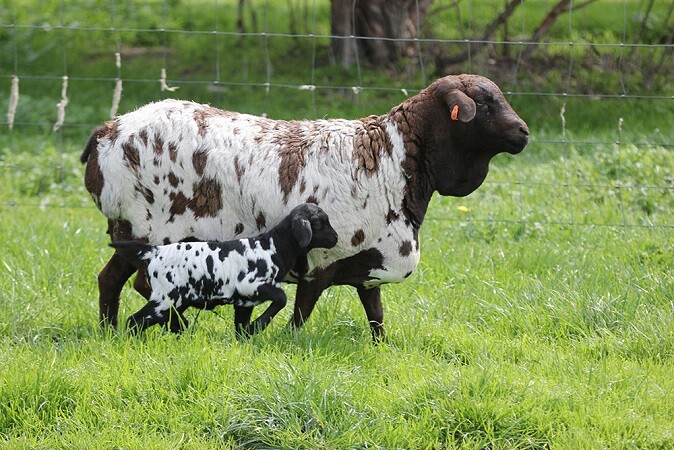

Many people when seeing Persian sheep for the first time mistake them for goats. They are however a handsome breed of sheep. The outstanding feature of Persian sheep is their colour and pattern. Persian sheep come in two basic varieties:
1. Coloured head(kleur kop in Afrikaans)– in this variety the entire sheep is white except for the head which can be either black, brown, red, tri-colour or blue.
2. Harlequin or Speckled – these sheep have solid coloured heads, legs and tails, while the body is covered with spots and patches on a white background. The pattern on each individual sheep is unique. Harlequin Persians are called ‘Skilder Sheep’ in Afrikaans which literally means painted sheep . This term describes these beautiful animals well. These sheep are extremely attractive and can also either be black, brown, red, tri-colour or blue
Both varieties can be routinely inter-bred and the resultant lambs always have the distinct pattern of one variety or the other. Genetically the ‘coloured head’ pattern is recessive to the harlequin pattern. This means that to breed a ‘coloured head’ lamb either both parents must have coloured heads or be carrying the ‘coloured head’ gene
In both varieties the hooves are coloured and match the coat colour. The ewes do not have horns. The rams also generally do not have horns but approximately one in fifty rams having small horns that sit flat against the head.
Persian sheep also have a number of distinctive structural features. They have a large flap of skin called the ‘dewlap’ which extends below their throat and also a prominent anterior breast bone called the ‘manubrium’. When in good condition they store fat naturally in an area around the tail base. This fat can be used as an energy source and is a characteristic shared by some other African breeds of sheep. Because of this characteristic this group has sometimes been referred to as ‘fat bottomed’ sheep.
Persian sheep have a unique tail which is about the size of a human finger and sits at a somewhat quirky angle on top of the tail fat pad. The first part of the tail is attached to the rump while the second part is pushed upwards and ends in the tassel or ‘sambokkie’ which hangs down perpendicularly. The overall appearance is that of an attractive, exotic animal.
Persian lambs reach maturity at an early age and thus also put on fat early. The fatty tail is used in venison products such as dry wors and processed meats.
The skin of the Blackhead Persian is remarkably thin and tough, making it suitable for the manufacturing of leather gloves.
Rams have an average birthweight of 2,6kg, while ewes weigh on average 2,55kg at birth. Mature weights are 68kg and 52kg for rams and ewes respectively.
The Blackhead Persian is one of the parent breeds of the well-known Dorper breed. It also played a role in the upgrading of the Karakul.
 Contact Jaguza Support
Contact Jaguza Support